Mitch and Bill are both age 75. When Mitch was 25 years old, he began depositing $1200 per year into a savings account. He made deposits for the first 10 years, at which point he was forced to stop making deposits. However, he left his money in the account, where it continued to earn interest for the next 40 years. Bill didn't start saving until he was 46 years old, but for the next 29 years he made annual deposits of $1200. Assume that both accounts earned an average annual return of 7% (compounded once a year). Complete parts (a) through (d) below. a. How much money does Mitch have in his account at age 75? At age 75, Mitch has $ in his account. (Round to the nearest cent as needed.). b. How much money does Bill have in his account at age 75? At age 75, Bill has $ in his account. (Round to the nearest cent as needed.). c. Compare the amounts of money that Mitch and Bill deposit into their accounts. Mitch deposits $ in his account and Bill deposits $ in his account. d. Draw a conclusion about this parable. Choose the correct answer below. OA. Both Bill and Mitch have the same return on their investments despite using different methods of saving. n n D-FL 5:11 L4-L --4 ... AL AL _f
Mitch and Bill are both age 75. When Mitch was 25 years old, he began depositing $1200 per year into a savings account. He made deposits for the first 10 years, at which point he was forced to stop making deposits. However, he left his money in the account, where it continued to earn interest for the next 40 years. Bill didn't start saving until he was 46 years old, but for the next 29 years he made annual deposits of $1200. Assume that both accounts earned an average annual return of 7% (compounded once a year). Complete parts (a) through (d) below. a. How much money does Mitch have in his account at age 75? At age 75, Mitch has $ in his account. (Round to the nearest cent as needed.). b. How much money does Bill have in his account at age 75? At age 75, Bill has $ in his account. (Round to the nearest cent as needed.). c. Compare the amounts of money that Mitch and Bill deposit into their accounts. Mitch deposits $ in his account and Bill deposits $ in his account. d. Draw a conclusion about this parable. Choose the correct answer below. OA. Both Bill and Mitch have the same return on their investments despite using different methods of saving. n n D-FL 5:11 L4-L --4 ... AL AL _f
Chapter3: Income Sources
Section: Chapter Questions
Problem 41P
Related questions
Question
100%

Transcribed Image Text:K
Mitch and Bill are both age 75. When Mitch was 25 years old, he began depositing $1200 per year into a savings account. He made
deposits for the first 10 years, at which point he was forced to stop making deposits. However, he left his money in the account, where
it continued to earn interest for the next 40 years. Bill didn't start saving until he was 46 years old, but for the next 29 years he made
annual deposits of $1200. Assume that both accounts earned an average annual return of 7% (compounded once a year). Complete
parts (a) through (d) below.
a. How much money does Mitch have in his account at age 75?
At age 75, Mitch has $ in his account.
(Round to the nearest cent as needed.)
b. How much money does Bill have in his account at age 75?
At age 75, Bill has $
in his account.
(Round to the nearest cent as needed.)
c. Compare the amounts of money that Mitch and Bill deposit into their accounts.
Mitch deposits $ in his account and Bill deposits $ in his account.
d. Draw a conclusion about this parable. Choose the correct answer below.
OA. Both Bill and Mitch have the same return on their investments despite using different methods of saving.
DELL D:11
.
AA1_L
...1L 1L-
14 L.. KA1-LL-LA
Expert Solution
This question has been solved!
Explore an expertly crafted, step-by-step solution for a thorough understanding of key concepts.
This is a popular solution!
Trending now
This is a popular solution!
Step by step
Solved in 3 steps with 2 images

Follow-up Questions
Read through expert solutions to related follow-up questions below.
Follow-up Question

Transcribed Image Text:d. Draw a conclusion about this parable. Choose the correct answer below.
OA. Both Bill and Mitch have the same return on their investments despite using different methods of saving.
OB. Both Bill and Mitch end with the same amount of money in their accounts, but Mitch had to deposit less money using his
method. It is better to start saving as early as possible.
OC. Mitch ends up with more money in his account despite not having deposited as much money as Bill because the interest
is initially accumulated accrues interest throughout the life of the account.
O D. Bill ends up with more money in his account than Mitch because he make more deposits than Mitch, and each additional
deposit will accrue interest each year.
Solution
Knowledge Booster
Learn more about
Need a deep-dive on the concept behind this application? Look no further. Learn more about this topic, finance and related others by exploring similar questions and additional content below.Recommended textbooks for you







Individual Income Taxes
Accounting
ISBN:
9780357109731
Author:
Hoffman
Publisher:
CENGAGE LEARNING - CONSIGNMENT

